
By Grant Schwalbe
Search and rescue go hand in hand. Often, when we train on search, we neglect the rescue element—like throwing ladders but never climbing one to get in a window. My initial fire service training involved learning search without any hands-on instruction in victim removal. I had to rely on the pictures in the textbook. In one photo, three firefighters were standing up and holding a victim and in two others, two firefighters were carrying a victim in a chair.
Victims are most often found in primarily one of two places: in a path of egress or in a bedroom. Logically, if the victim were five to 10 feet inside the front door, we would simply drag him out quickly. But if the victim is found in a bedroom behind a closed door, we must be careful not to cause more harm.
RELATED
Truck Company Ops: Victim Removal Down Ladders, Part 1 | Part 2
Search Mission Prep: Size-Up, Methods, and Tools
Training Minutes: Victim Removal Techniques
We say it often in our classes, “If you crawl through a smoky, hot hallway and open up a bedroom door and find my mom and you take her out the way you came in, you may have just committed murder.” We must remember the civilian is unprotected and recognize when conditions in a tenable room with a victim are better than those in the location from where you just came. Maybe we just have to close the door and wait for conditions to improve, or maybe we opt to take the victim out the window. For this option, crews must be proficient with window lifts and ladder removal.
As for a victim drag, we must know how to do this; “just make it happen” is not a plan. We must train to be able to drag a victim 10 to 20 feet (to the front door if in a path of egress or to a window if in a tenable bedroom). The plan needs to be executable under stressful conditions. A plan that includes knot tying isn’t a good option because during stress-induced tachycardia, when our heart rate nears 115 beats per minute, we begin to lose our fine motor skills. For this reason, if you carry webbing or rope and plan to use it for victim removal, have it pretied in a loop.
How we drag a victim out is typically dictated by the position in which the victim was found, which we know because we see it frequently on emergency medical services responses. Cardiac-arrest victims are found down in a bathroom or in the two-foot space between a wall and a bed in a trailer. Cramped conditions and furniture can often make it difficult or impossible to reposition a victim into a more favorable position. For this reason, we must have a headfirst and a feetfirst plan for dragging.
Drags are recommended instead of carries because they are generally safer for the victim. Not only does a carry change the rescuer’s center of gravity, making falls more likely, but a carry also makes the victim more susceptible to spinal compromise if the rescuer were to fall. Although not recommended for the adult victim, a carry may be indicated in hoarding conditions or when removing children.
Feetfirst Leg Drag
Using the victim’s legs as handles, the rescuer reaches on the outside of the victim’s legs, getting the rescuer’s elbows behind the victim’s knees. The rescuer squeezes the legs into his body. The victim’s torso stays on the ground. If the victim is still breathing, this keeps him where the air is the coolest and the cleanest. It makes no sense to lift the heaviest part of the victim’s body and to elevate the airway into an environment two to three feet off the ground that is hotter and smokier. Note that while the rescuer is moving backward, another firefighter is often leading him and they are both moving toward the exit (photos 1-2).
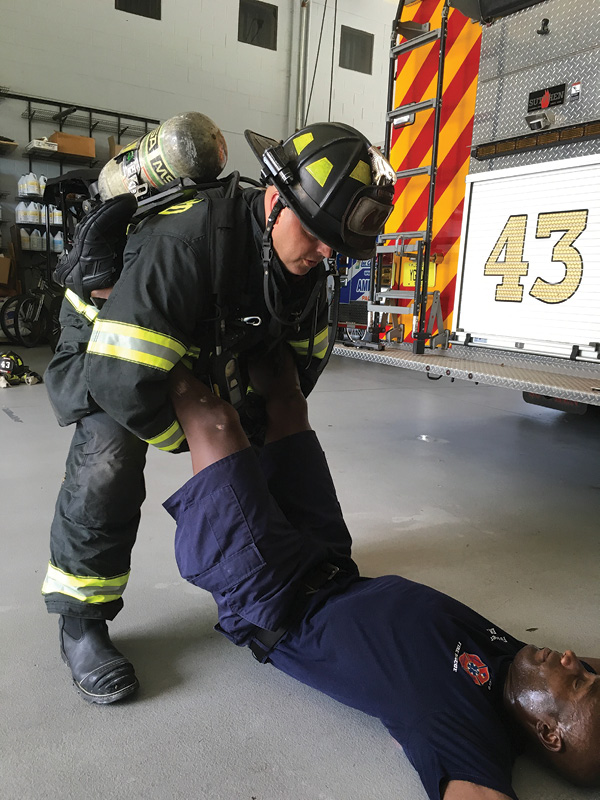

(1) Photos by Jason Richards.
Feetfirst Girth Hitch
You can use a seven-foot prusik tied in a loop (a double fisherman’s knot) in this drag. Place the loop over the victim’s feet and girth-hitch it around the feet. This drag allows two firefighters (if needed) to drag the victim (if dealing with a larger victim). When doing drags, the victim’s positioning is important. When pulling the body, it’s quickest to move in a tripod position. The most efficient stance is front hand down and front knee down, back leg up. This allows you to squat the victim’s weight rather than row it. Consider the statement “The heel is the motor” from Aaron Fields (Nozzle Forward) when getting into position (photos 3-4).
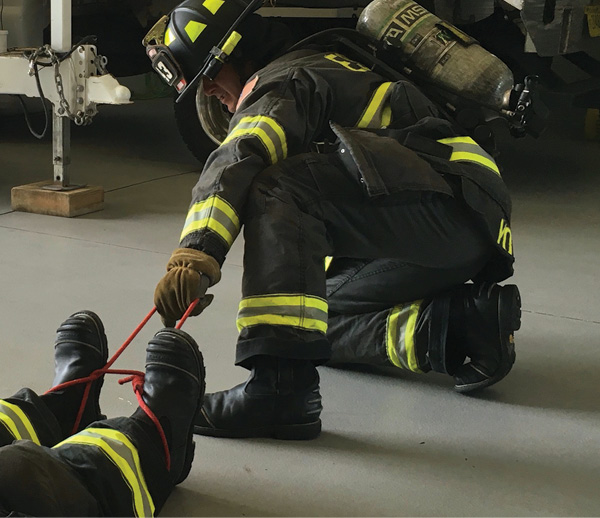
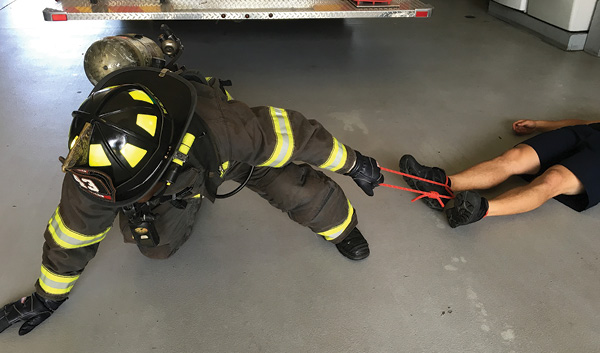
Headfirst Arm Lock Drag
Bring the victim’s arms above his head and cross the arms at the forearms or wrists. The rescuer reaches through the arms (under) with his dominant arm and then locks the other arm on top, sandwiching the victim’s arms together. This is great for a drag of 10 to 15 feet, whether you are dragging in the path of egress to the front door or moving the person to an area in which to reposition him for a feetfirst drag (photo 5).
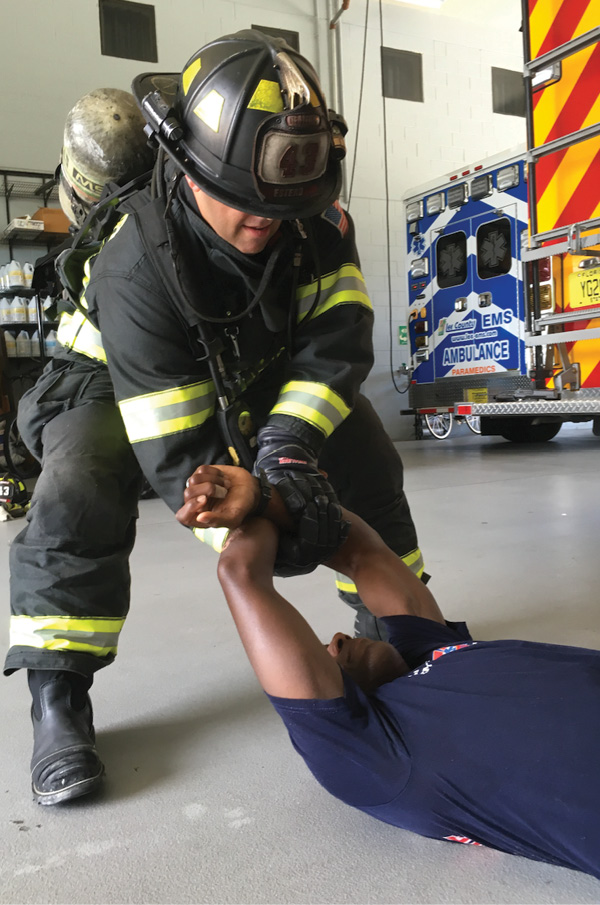
Headfirst Sheet/Webbing Drag
For larger victims, it may be necessary to help get a grip. You can use a sheet, drapes, or even pants—all found in the room—to help with the drag. Place whatever you are using at the victim’s head. Either sit the victim up or use the arm drag to get it behind the victim’s shoulders. Bring the ends of the sheet (or whatever you are using) underneath the armpits and up to the head. Note that webbing can also be used in the same manner. I’ve found that you need to double up your webbing for the right length. Using webbing or a sheet also allows for a second rescuer to assist in the drag if necessary (photos 6-7).
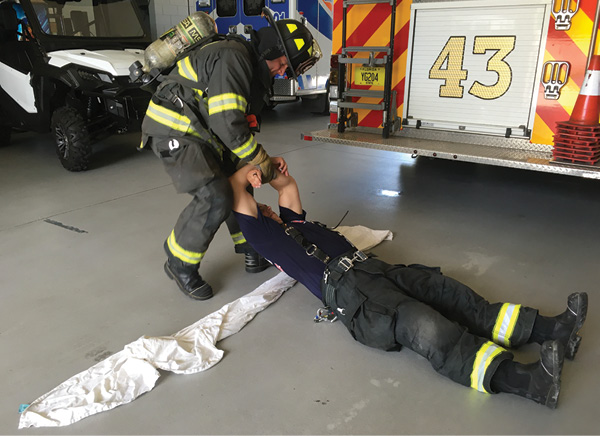
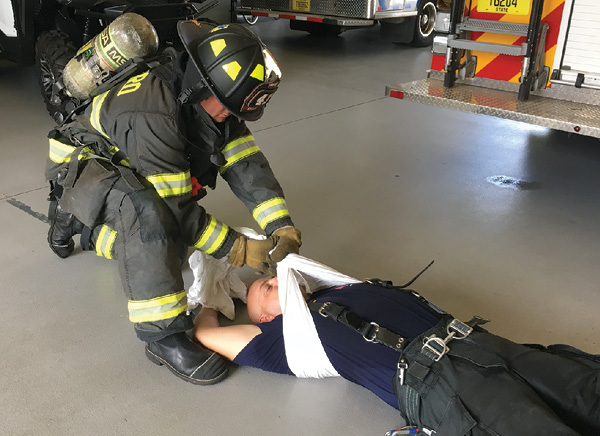
The next time you do search drills, cover victim removal as well. Integrate rescuer decision making by telling the trainees the conditions of the room in which the victim was found compared to the conditions in their path of travel. Review drags and window lifts. Once the crew has the drags and window lifts down, have them perform them in zero-visibility conditions. End the session with a short scenario incorporating everything you’ve worked on.
GRANT SCHWALBE, a 23-year veteran of the fire service, is a lieutenant on Engine 43 for Estero (FL) Fire Rescue. He is an instructor for When Things Go Bad, Inc. and the Fort Myers Fire Academy. He is lead instructor for the FDIC International H.O.T. evolution “Residential Search—Making the Grab.”

